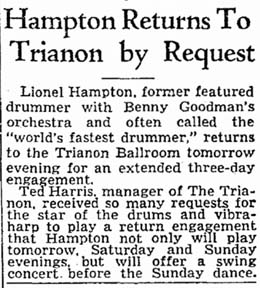On August 31, 1951, the Lionel Hampton Orchestra performs at Seattle's popular Trianon Ballroom (218 Wall Street). The building's marquee touts two young local musicians-made-good who had joined the nationally famous band: trumpeter Quincy Jones and singer Janet Thurlow.
Trianon Tales
The Trianon Ballroom was an important but flawed entertainment venue in Seattle's music history. The racially segregated hall was founded by an experienced and well-connected white nightlife veteran, John E. Savage, who for years had managed the Butler Hotel on 2nd Avenue. The hotel's Rose Room had featured a Prohibition Era speakeasy that had long offered live music and illicit liquor to crowds that included some of the city's most prominent citizens, along with many jazz-loving college kids. Barely hiding its illegal activity, the Rose Room was often raided by lawmen, occasionally shut down, and then reactivated. By 1927 Savage was ready to move on, and on May 20 of that year he threw a Grand Opening party for his new Trianon Ballroom in the Denny Regrade. The Trianon, which covered a half block and had a 30-by-135-foot dance floor that accommodated more than 5,000 dancers, was hyped as "the largest dancehall west of Chicago." Savage's partner in the enterprise, bandleader Herb Wiedoeft (1886-1928), brought his Brunswick Recording Orchestra from Los Angeles to perform.
For the next three decades the Trianon was the site of many fabled shows and events. One concerns the ballroom's policy of racial exclusion, which Savage, for years on end, maintained was necessary due to a Seattle city ordinance prohibiting "mixed [race] dancing" (Cleary). On May 24, 1940, white Seattle attendees saw a concert at the Trianon by the Benny Goodman Orchestra, which then included the Black drumming star Lionel Hampton (1908-2002). Meanwhile, Hampton had formed his own 15-piece orchestra, and Seattle's growing Black community soon learned that his big band, which included Seattle jazz singer Evelyn Williamson, was on tour and that some concert/dance dates (October 9-12, 1940) were already booked at the Trianon -- which meant that they would not be allowed to attend. Community leaders made contact with then-manager Ted Harris to plead that Blacks finally be allowed to enter the hall, and they received a counteroffer: if the local Black-oriented newspaper, the Northwest Enterprise, would sponsor a second night's show, there could be a special "Colored Folks" night.
The newspaper's editors, committed to battling racist policies in general, balked at the idea. But the show did occur after Seattle's "Negro Musicians' Union," AFM Local 493, stepped up and sponsored a second Hampton show on October 14. Trianon management still felt it necessary to promote Hampton's shows with questionable language, describing Hampton's music as "Savage Rhythm," while The Seattle Times pointed out that Hampton was a "Negro sensation" and that he "recently organized his new orchestra, which includes some of the best Negro musicians in the country" ("Lionel Hampton at Trianon …"). Thus began a series of such segregated shows held at the Trianon on Monday nights.
Seattle's Scene
Hampton -- vibraphonist, pianist, and "the world's fastest drummer," who initially gained fame with the Benny Goodman Orchestra ("Hampton Returns …") -- continued recruiting new band members from a pool of excellent players and singers on Seattle's vibrant jazz scene, including famed singer Ernestine Anderson (1928-2016) for a time in 1952. Earlier, in 1950, he added singer Janet Thurlow (1926-2022), formerly with Robert "Bumps" Blackwell's (1918-1985) Seattle-based band. Thurlow, who sang on Hampton's Decca record "I Can't Believe You're in Love With Me," made history in Hampton's band as "the first white singer to front a black big band" (de Barros, 85). Thurlow soon prompted her boss to hire young Seattle trumpeter Quincy Jones (1933-2024).
Working with Hampton meant endless dates touring around the nation, and in the late summer of 1951 the 22-member orchestra returned to Seattle for shows on Friday, August 31. By this time the promoters were aware of the pride locals felt about having two of their own associated with a famous musical ensemble, and the Trianon's marquee touted the fact that both Jones and Thurlow would be performing. Its display ad published in The Seattle Times read: "COMING! ... THE AMAZING! ... LIONEL HAMPTON -- His Famous Orchestra & Stars -- Featuring Two Seattleites QUINCY JONES & JANET THURLOW" and "Greatest Musical Entertainment Ever Offered Anywhere."
The show must have been great, even if attending remained an obstacle for many because the Trianon was still racially segregated. Even the authoritative national jazz magazine down beat noted of a Trianon performance that Thurlow was a "home-town girl who … [is] … a soulful interpreter of modern songs" (de Barros, 84). And although Thurlow's career would prove to be short-lived, Jones would go on to enjoy a fabulous life at the top of the music business as a player, arranger, manager, and multi-Grammy Award-winning producer.

